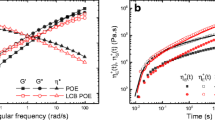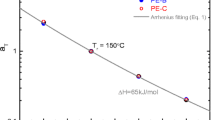Abstract
Fiber orientation and rheological properties of short fiber-reinforced polystyrene at high shear rates were investigated by scanning electron microscopy (SEM) and rheometry. This is the first attempt to observe fiber orientations in samples taken from inside the capillary as well as taken from the extrudate by employing SEM. The fiber orientations near the center of the capillary are similar to those near the wall. Also, the fiber orientations inside the capillary changed very little, even if the shear rate was varied from 25.4 to 3110 s−1. This is because most fibers near the center as well as near the wall of the barrel are already aligned toward the flow direction before entering the capillary. The possible sources to induce surface roughness of the extrudate or fiber protrusion are discussed. It appears that the surface roughness depends mainly upon the velocity rearrangement at the capillary exit. Interestingly, fiber flexing was seen in the filament taken from the extrudate as well as from inside the capillary, which suggests that this is not likely a dominant source for inducing surface roughness.
Similar content being viewed by others
References
C. L. Tucker III and S. G. Advani, in “Flow and Rheology in Polymer Composites Manufacturing,” edited by S. G. Advani (Elsevier, New York, 1994).
Y. Chan, J. L. White and Y. Oyanagi, J. Rheol. 22 (1978) 507.
V. M. Lobe and J. L. White, Polym. Eng. Sci. 19 (1979) 617.
H. Tanaka and J. L. White, ibid. 20 (1980) 949.
L. Czarneckiand J. L. White, J. Apply. Polym. Sci. 25 (1980) 1217.
B. Chung and C. Cohen, Polym. Eng. Sci. 25 (1985) 1001.
H. M. Laun, Coll. Polym. Sci. 262 (1984) 257.
A. Vaxam, M. Narkis, A. Siegmann and S. Kenig, Polym. Compos. 10 (1989) 78.
G. Ausias, J. F. Agassant, M. Vincent, P. G. Lafleur, P. A. Lavoie and P. J. Carreau, J. Rheol. 36 (1992) 525.
M. L. Becraft and A. B. Metzner, ibid. 36 (1992) 143.
J. P. Greene and J. O. Wilkes, Polym. Eng. Sci. 35 (1995) 1670.
C. D. Han, “Multiphase Flow in Polymer Processing” (Academic Press, New York, 1981).
J. L. White, “Principles of Polymer Engineering Rheology” (John Wiley & Sons, New York, 1990).
S. Wu, Polym. Eng. Sci. 19 (1978) 638.
R. J. Crowson, M. J. Folkes and P. F. Bright, ibid. 20 (1980) 925.
B. A. Knutton and J. L. White, J. Appl. Polym. Sci. 26 (1981) 2347.
A. Wagner, R. Yazici and D. M. Kalyon, Polym. Compos. 17 (1994) 840.
J. K. Kim and J. H. Song, J. Rheol. 41 (1997) 1061.
W. P. Cox and E. H. Merz, J. Polym. Sci. 28 (1958) 619.
M. Doi and S. F. Edwards, “The Theory of Polymer Dynamics” (Clarendon Press, Oxford, 1986).
Author information
Authors and Affiliations
Rights and permissions
About this article
Cite this article
Kim, J.K., Park, S.H. Fiber orientation and rheological properties of short fiber-reinforced plastics at higher shear rates. Journal of Materials Science 35, 1069–1078 (2000). https://doi.org/10.1023/A:1004782924666
Issue Date:
DOI: https://doi.org/10.1023/A:1004782924666




